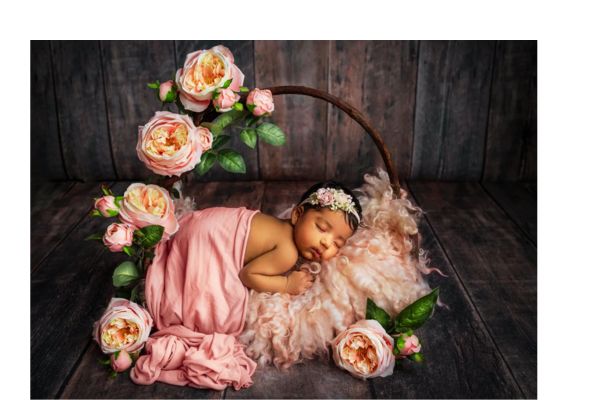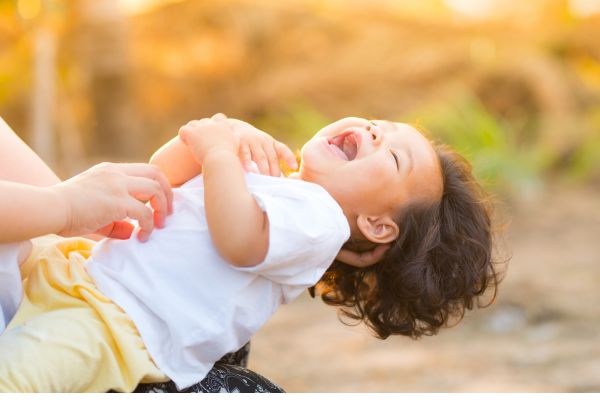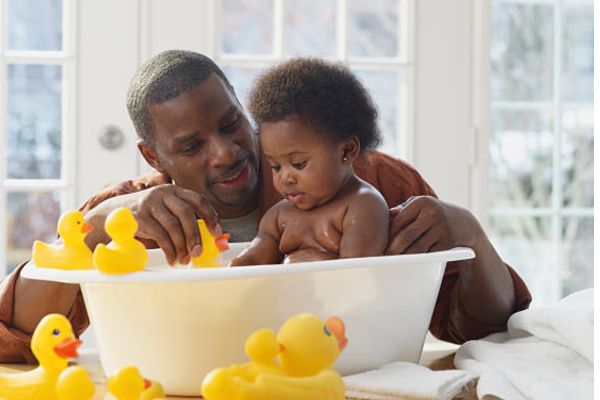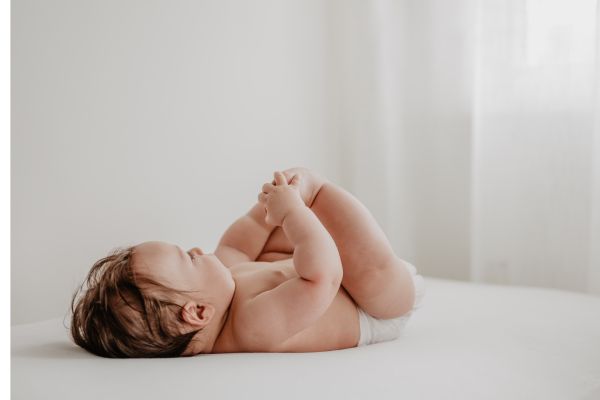
Adhering to appropriate hygiene habits is crucial for the health and welfare of a newborn girl. To protect her sensitive skin and avoid infections, careful attention is needed throughout everything from bathing rituals to changing diapers. We will go over five basic hygiene habits in this tutorial, which are specially designed with newborn girls’ requirements in mind. By following these guidelines, parents and other caretakers can establish a healthy, clean, and secure atmosphere for their children. In order to provide our priceless infant girls with the best attention possible, let’s explore 5 proper hygiene practices for a baby girl.

How to Bathe a Baby: Crucial Cleaning Procedures for Your Baby Girl
Bathing your baby girl is not just a routine; it’s an opportunity to bond and ensure her comfort and hygiene. While it may seem straightforward, there are specific techniques and considerations to ensure her delicate skin remains healthy and free from irritation or infection. Here’s a detailed guide to mastering the art of baby bathing
Gentle Cleaning: Compared to adult skin, baby skin is far more sensitive and delicate. Regular soaps’ harsh chemicals and perfumes can strip your baby’s skin of its natural oils and upset its pH balance, causing dryness, irritation, or even allergic responses. Baby soap without fragrance is made with mild chemicals that effectively cleanse the skin without irritating it or triggering allergic reactions.
Preventing Skin Irritation: Adult soaps sometimes contain fragrances and chemicals that are harsh on a baby’s sensitive skin, causing rashes, itching, and redness. You may reduce your baby’s chance of these negative responses and keep their skin healthy, smooth, and silky by using mild, fragrance-free baby soap.
Preventing Allergic Reactions: Babies’ immune systems are still developing, so they may be more vulnerable to irritants and allergens included in scented goods. Using fragrance-free baby soap makes bathing your child safer by lowering the possibility of allergy reactions or sensitivity reactions.
Preserving Skin Humidity: Compared to adult skin, baby skin tends to lose moisture more quickly, leaving it more vulnerable to dryness and discomfort. Baby skin has a natural moisture balance that can be preserved with the use of mild, fragrance-free soap, avoiding over dryness and preserving suppleness.
Safety Concerns: For your baby’s safety during bath time, use warm water and mild, fragrance-free baby soap. Your baby’s sensitive skin might be burned by hot water, and it can hurt from cold water. Your baby girl will have a pleasurable bathing experience because warm water is kind and calming.

Importance of Bathing
Hygiene and cleanliness: Bathing keeps your baby clean and lowers the chance of skin irritations or infections by removing dirt, perspiration, bacteria, and other pollutants from her skin. Babies can quickly gather dirt and detritus from feeding, changing diapers, and exploring their surroundings, among other activities. Bathing on a regular basis helps them stay clean and avoid common skin problems like cradle cap or nappy rash.
Bonding Opportunity: Giving newborns a bath is a unique way for carers and babies to bond. It’s an opportunity to engage in close proximity, make eye contact, and use gentle touch to deepen the emotional tie between parents and children. Carers can reinforce feelings of security and trust by positively associating bath time with happy experiences, comforting words, and playful interactions.
Stimulation and Relaxation: Bath time is a great way to stimulate and relax your baby’s senses by allowing her to interact with objects, people, and music. Your infant may unwind and relax with the help of the warm water, soft splashing, and soothing vibrations, which can be both comforting and exciting. Many babies look forward to their bath time and love the sensory stimulation it provides.
Regulating Body Temperature: Bathing can help regulate your baby’s body temperature, especially during hot weather or after physical activity. The warm water can have a calming effect on your baby’s nervous system, promoting relaxation and helping her maintain a comfortable body temperature. After the bath, the gradual cooling down process can also prepare your baby for bedtime, promoting better sleep.
Skin Care: Proper bathing techniques, including the use of mild, fragrance-free baby soap and warm water, help maintain the health and integrity of your baby’s skin. By keeping her skin clean and moisturized, you can prevent dryness, irritation, and other skin conditions. Additionally, gentle cleansing of the diaper area during bath time can help prevent diaper rash and discomfort.
Important body part to clean
Babies’ bodies are covered in creases and folds, especially in the groined, thighs, neck, and armpits. These areas are prone to accumulating perspiration, filth, and moisture, which, if improperly cleansed, can lead to irritation and even infections. It’s important to pay close attention to these folds and creases when giving your infant a bath in order to guarantee complete cleaning and avoid problems like nappy rash or fungal infections.
Neck: Using a gentle, wet cloth or sponge, gently lift your baby’s neck to reveal the folds underneath. Be careful not to hurt the infant or inadvertently press against their sensitive skin.
Armpits: Gently massage your baby’s armpits in gentle circular motions while lifting each arm individually. Make sure you get inside the creases to get rid of any collected dirt or debris.
Thighs and Groined: Gently separate your baby’s legs and clean the area around the groined, taking care of the creases where the thighs and torso connect. Since these areas are prone to irritation, pay special care to any areas where nappy elastic may come into contact with the skin.
To avoid infections, gently wash the genital area, wiping from front to back:
Maintaining your newborn girl’s hygiene and avoiding urinary tract infections (UTIs) and other issues requires proper cleaning of the vaginal area. This is a critical stage, and here’s how to do it well:

Wiping from Front to Back: Always wipe the genital area from front to back, moving away from the vagina and towards the anus. This orientation lowers the incidence of urinary tract infections (UTIs) and other illnesses by preventing the passage of microorganisms from the anal area to the urinary system.
Use a Clean Cloth: To clean the genital area, use a separate, clean cloth or cotton ball. To avoid cross-contamination, don’t use the same cloth that you used on other body parts.
Gently Cleansing: Avoid violently rubbing or cleaning the vaginal area; instead, use gently, downward strokes. Excessive rubbing might irritate the delicate and sensitive skin in this area.
Pat Dry: Before putting on a new nappy, pat dry the genital area with a gentle cloth or let it air dry after cleansing. Make sure the region is totally dry to avoid any moisture accumulation that could lead to fungal infections or nappy rash.
Optimal Diaper Area Cleansing
Choosing the Right Cleansing Products: Fragrance-free wipes or warm water and a soft cloth are gentle options for cleaning your baby’s diaper area. Fragrance-free wipes are convenient for on-the-go diaper changes, while warm water and a soft cloth provide a more thorough cleanse at home.
Avoiding Irritation: Fragrances and harsh chemicals found in some wipes can irritate your baby’s sensitive skin, leading to discomfort or allergic reactions. Opting for fragrance-free wipes or warm water and a soft cloth minimizes the risk of irritation and keeps your baby’s skin clean and healthy.
Apply a thin layer of diaper cream to protect against irritation
Barrier Protection: The wetness, friction, and irritants included in pee and faeces create a barrier that nappy cream fills, shielding your baby’s skin. This barrier relieves current irritation and helps avoid nappy rash.
Selecting the Best Diaper Cream: Seek out diaper creams with zinc oxide or other calming components that are well-known for their ability to protect skin. These creams form a barrier to prevent future irritation while also aiding in the healing of inflamed skin.
Selecting the Best Diaper Cream: Seek out diaper creams with zinc oxide or other calming components that are well-known for their ability to protect skin. These creams form a barrier to prevent future irritation while also aiding in the healing of inflamed skin.
Application Method: After every diaper change, massage a thin, even coating of diaper cream over your baby’s clean, dry skin. Particular attention should be given to regions like the buttocks and nappy folds that are prone to redness or irritation. Steer clear of overapplication, since this can cause needless product accumulation and trouble adhering to diapers.

Cleaning of the Umbilical Cord
Gently Clean: When changing a diaper, gently wipe the area around the base of the umbilical cord stump with a clean, soft cloth that has been soaked with warm water. Avoid pulling or tugging on the cord stump as this may result in pain or even bleeding.
Pat Dry: Using a soft, absorbent cloth, gently pat dry the region surrounding the stump of the umbilical cord after cleaning. Releasing too much pressure or rubbing might aggravate the sensitive area and slow down the healing process.
Air Circulation: Allow air to circulate around the umbilical cord stump by folding down the top of your baby’s diaper or dressing her in loose-fitting clothing. This helps keep the area dry and promotes healing.
Avoid submerging the baby in water until the stump falls off:
Water Exposure: It’s imperative to keep your infant out of the water, including in a bathtub or sink bath, until the umbilical cord stump falls off naturally. Adding water to the stump might delay its healing and raise the risk of infection.
Sponge Baths: To keep your infant clean and away from the umbilical cord stump, use sponge baths as an alternative to regular baths. Gently wash her body with a soft cloth or sponge dipped in warm water, paying special attention to areas where she tends to perspire and accumulate filth.
Consult a pediatrician if there are signs of infection or unusual discharge:
Infection Symptoms: Pay special attention to any redness, swelling, warmth, or foul-smelling discharge on the umbilical cord stump. These signs could point to an underlying infection that needs to be treated right once.
Unusual Discharge: You should notify your pediatrician of any unusual discharge or heavy bleeding, even if some minor seeping or bleeding around the umbilical cord stump is common while it heals. They are able to evaluate the circumstances and offer the proper advice or care to guarantee the wellbeing of your infant.
Prompt Medical Attention: Do not hesitate to speak with your pediatrician if you have any questions or concerns regarding the care of your baby’s umbilical cord. They can provide tailored guidance based on the unique requirements and conditions of your kid, promoting maximum recovery and lowering the possibility of problems.
Clothing and Bedding
Breathable Fabrics: Choose apparel composed of organic, breathable materials like bamboo or cotton. By allowing air to circulate, these materials help to control and avoid overheating in your baby.
Loose Fit: Wear apparel that fits loosely and doesn’t impede your movement. Your infant may feel uncomfortable wearing tight or restrictive clothing, which can also limit airflow and cause overheating or skin irritation.
Dressing for the Weather: Take the weather into account while choosing clothes for your infant. When the weather gets colder, dress her in layers so you can simply modify her clothes to keep her at a comfortable temperature. Choose airy, light-weight clothing in warmer months to keep her cool and comfortable.
Wash clothes and bedding with mild detergent to avoid skin irritation:
Hypoallergenic Detergent: Make use of a gentle, hypoallergenic detergent designed especially for bedding and clothes for babies. The harsh chemicals and scents that could harm your baby’s delicate skin are absent from these detergents.
Steer clear of fabric softeners: They might contain ingredients that irritate your baby’s skin by leaving residues on bedding and clothes. It is recommended that you should not use fabric softeners when washing clothes for your infant.
Make Sure to Rinse Well: To get rid of any detergent residue, make sure to rinse clothing and bedding well. Thoroughly rinsing goods before drying and use is crucial because detergent residue left on materials can irritate skin.
Change bedding regularly to maintain cleanliness and prevent allergen buildup:
Frequent Changes: Change your baby’s bedding regularly to maintain cleanliness and hygiene. Aim to change sheets and crib bedding at least once a week, or more frequently if they become soiled.
Allergen Prevention: Regularly changing bedding helps prevent the buildup of allergens such as dust mites, which can trigger allergies or respiratory issues in sensitive individuals. Washing bedding in hot water can further help eliminate allergens and bacteria.
Use Protective Layers: Consider using mattress protectors or waterproof pads to protect the mattress from accidents or spills. These protective layers can help extend the life of the mattress and make cleanup easier.

Conclusion
Taking care of a baby girl’s hygiene is essential to her general care and development; it goes beyond simple cleaning. We reduce the chance of diaper rash and discomfort by making frequent diaper changes a priority, which supports healthy skin. Her sensitive tissues are protected when the vaginal area is gently cleaned to help prevent discomfort and infections.
By using gentle, baby-safe products and practicing proper skincare, her delicate skin is shielded from irritation and dryness. By gently trimming her nails, you may keep her safe and happy by lowering the chance of unintentional scratches. Furthermore, keeping her surroundings clean—this includes washing her toys and bedding on a regular basis—minimizes her exposure to allergies and bacteria and strengthens her immune system.
In conclusion, these behaviors help the newborn girl feel secure and at ease and improve her physical health. They show how dedicated we are to her well-being as carers, setting the foundation for a lifetime of healthy habits and self-care. Setting her appearance as a top priority becomes a crucial component of her entire care regimen as we provide her with love and care, ensuring that she lives in a secure and healthy environment.